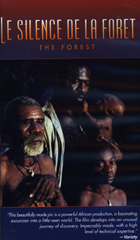
Le Silence de la Foret: The Silence of the Forest 2002
Distributed by California Newsreel, Order Dept., PO Box 2284, South Burlington, VT 05407; 877-811-7495 (toll free)
Produced by Bassek ba Kobhio and Didier Quenangare
Directed by Bassek ba Kobhio and Didier Quenangare
VHS, color, 90 min.
College - Adult
African Studies, Anthropology
Date Entered: 07/13/2004
Reviewed by Charles Burkart, Head, Audiovisual Library, West Virginia University, Morgantown, WVCalifornia Newsreel is known for its fine Library of African Cinema collection, which has to be the premier collection of African films available today. Certainly, Le Silence de la Foret lives up to the reputation of earlier releases: Hyenas, La Genese, Monday’s Girls and others.
Le Silence de la Foret is an uncompromising look at corruption in post-colonial Africa and the modern tendency to romanticize less developed cultures. Gonaba, the film’s protagonist, is an African intellectual, educated in France, who returns to work in his Central African homeland. An idealist, Gonaba is disillusioned by the corruption and ineffectualness of the education ministry, where he works. He is particularly disgusted by the exploitation of the Biaka (pygmies), whose treatment strangely mimics the prejudice of the former white colonialists. In a rush of enthusiasm, enamored with Rousseau’s ideal of the “noble savage,” Gonada goes to live with the Biaka in the heart of the jungle. Unfortunately, the Biaka are happy with their traditional hunter-gathering way of life and rebel against Gonaba’s attempts to inculcate them with the best of Western culture. The story ends in a predictable tragedy.
Silence of the Forest is a beautifully photographed production with the breathtaking scenery of the Central African rainforest. Sound is excellent and the musical soundtrack (by Manu Dibango) is both pleasing and authentic. The film is very well edited and structured to maintain interest throughout. The color was also extremely vivid and lifelike.
I have only two minor criticisms of Le Silence de la Foret. First, the acting seemed rather amateurish in some places. Of course, the Biaka are not professional actors and were essentially playing themselves. Moreover, I exclude the film’s star, Eriqu Ebouaney, from this criticism as he is a fine performer, best known for his portrayal of Patrice Lumumba. Second, Gonada’s romance with the Biaka girl, Kali, seemed a little too contrived. Her romantic interests and subsequent death seemed totally predictable to me.
Overall, this is an admirable movie, entertaining, but with much to teach about contemporary Africa. It should join the other classic Library of African Cinema productions in every major college or university library collection. In addition, I feel that public libraries would find it a worthwhile acquisition. I enthusiastically recommend this splendid movie.